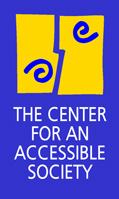
DISABILITY
ISSUES
INFORMATION
FOR
JOURNALISTS
ABOUT
THE CENTER
A slice of history now online
Note to readers: links to news articles may not work after a few weeks, as news media remove current stories to their archives. The link may take you to the archives section, where, for a fee, you can view the article.
July 9, 2002 -- "Do you drive? If you don't you should. If you do, you should drive better and with greater ease." Thus begins a page of advice to fellow "polios" at the Warm Springs Institute in 1933 -- a page from The Polio Chronicles newsletter, published by those who stayed at Warm Springs, Georgia, from 1931-34.
The Polio Chronicles offer a firsthand look at a slice of history of disability in the 1930s. They are now online, thanks to online Disability History Museum -- http://www.disabilitymuseum.org. "The materials provide fascinating insights into the histories of accessible architecture, assistive technology, the building of a disability community," says Disability Museum creator Laurie Block. They also show the large role Warm Springs played in the life of Franklin Roosevelt -- and the role he played at Warm Springs.
Over 200 documents and visuals give browsers the primary source data, much of it from Pres. Roosevelt himself, of life at Warm Springs. Other more recent documents on polio can also be found, including writings from the late Irving Kenneth Zola.
We learn at http://www.disabilitymuseum.org/lib/docs/964.htm that plans for accessible bathrooms were being drawn up by people with polio in the 1930s; at http://www.disabilitymuseum.org/lib/docs/1068.htm we read a letter from FDR to his friends back at Warm Springs; at http://www.disabilitymuseum.org/lib/docs/957.htm we learn that in the 1930s few states allowed people with degrees of paralysis to drive, even though "various mechanical contrivances can allow you to be your own highly competent chauffeur." This article, from a 1933 issue of the Chronicles, goes on to discuss changes disabled people of the time would work for to result in disabled people driving and is just one of many startling insights into the beginnings of a true disability community that can be found by browsing through the artifacts online at this site.
To get a full view of these documents, go to http://www.disabilitymuseum.org/search_lib.php and type "polio" into the search engine.
Funding for putting the Warm Springs material online was provided by the NEC Foundation of America and by the Roosevelt Warm Springs Institute for Rehabilitation Archives.